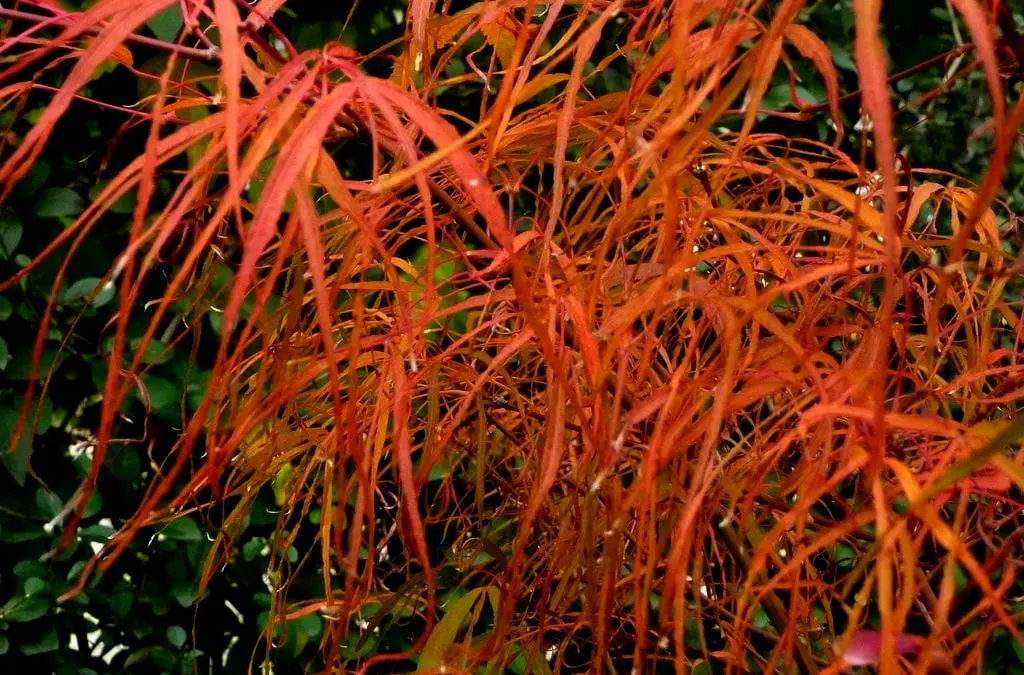We’ve heard from more than a few gardeners that their ornamental maples didn’t defoliate last fall. In fact, on walks through the neighborhood, Japanese Maples are the easiest trees to identify as they are completely covered with parchment colored leaves. True Japanese Maple aficionados, and I am certainly one of them, have been justifiably concerned. The Plant Desk has been counseling patience. For most varieties that are planted in this area, the buds should be visible. And as those new leaves unfurl, they’ll shed last year’s foliage.
Madison is not the only region affected. I belong to a Japanese Maple Facebook group (I never said that I wasn’t a plant geek) and have seen lots of sad photos from all over the Midwest and Southeastern United States. We tend to agree that the odd weather last autumn is the main culprit. The above-average temperatures in September, October and November were followed by a quick cold snap that likely interfered with the trees’ normal winter preparation process.
As the days shorten in fall, trees go through a series of changes, both biochemical and physical, in order to prepare for cold weather. With deciduous trees, these processes include the development of some cells where the leaf stems attach to the branches. This is called the abscission zone. This layer of cells seals off the branch to protect it from water loss as the tree defoliates. Last fall’s weather interrupted this process.
There are trees that naturally retain their dead leaves through the winter. If you’ve ever walked the paths of the Arboretum’s Wingra Woods in winter, you’ve surely noticed the rustle of dry papery leaves on the American Beeches. Many oaks keep their leaves on all winter as well. There is a theory that this trait developed so that acorns and nuts had a better chance of germination before the tree dropped a heavy carpet of leaves. This process has a $10 word that I’ve learned researching this post-leaf marcescence. There are other thoughts as to why trees do this, but the exact reasons haven’t been determined.
Now that we’ve determined that most of our Japanese Maples will leaf out normally, let’s consider how to make sure that we keep them healthy this growing season. Japanese Maples are one of the Garden Center’s most popular choices for small trees. The varied leaf colors and shapes, the graceful branching habits and the relatively small size, combine to create a stellar ornamental tree. With one huge exception. Japanese Maples are marginally hardy in Wisconsin. And even the warming trend that has shifted our planting zone from 4b to 5a doesn’t make up for our windy winters, late spring frosts and humid summers.
But don’t despair quite yet. Proper siting is the key. Make sure that your new maple is planted where it will have the best chance to thrive. My small Madison yard is home to 8 different Japanese Maples varieties. And I have plans for 2 new ones for this spring. First things first, your planting site must be protected from afternoon sun, all year long. The best spots are those on the eastern sides of permanent screens like buildings or evergreen hedges. This provides protection from heat and sweeping western winds, as well as the strong sun.
Japanese Maples also need that Holy Grail of soil, the type that is moist and well-draining. Soil in our area tends to be a bit heavy, so work in plenty of good chunky compost to improve the drainage. All trees, whether existing or newly planted, will need an inch of water per week to establish, and more than that if the summer is hot or dry. Give the root zones a generous 3-inch layer of bark mulch to keep the soil cool and help retain moisture. You’ll want to replenish this every year.
And what are my favorites? Last year I planted a very small ‘Koto-no-ito’, which means Harp Strings in Japanese. The thread-like leaves required a very sheltered spot and I hope that it survived the winter. My other pet is a Full Moon type called ‘Autumn Moon’ that was rescued from a mis-siting.
If you’re a newbie to the world of Japanese Maples, there are a few varieties that are more adaptable. ‘Bloodgood’ is the standard bearer for the red-leafed types. For spots with more sun than recommended, try the Korean Maple hybrids like ‘Jack Frost’ or ‘North Wind’. And then, let the collecting begin!


